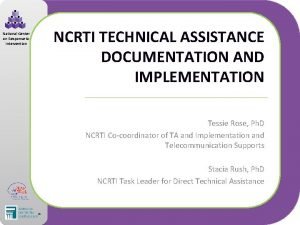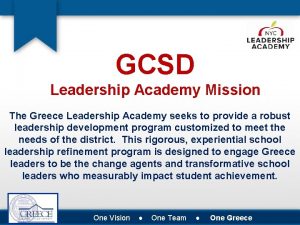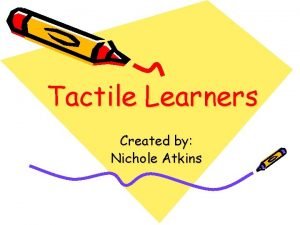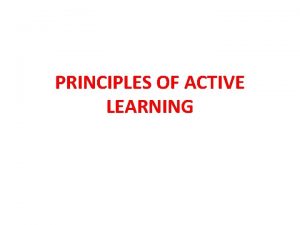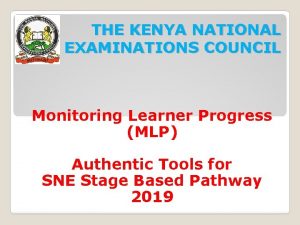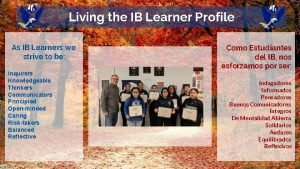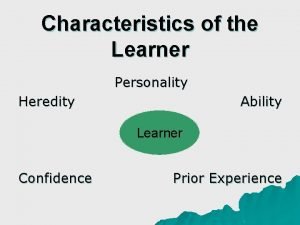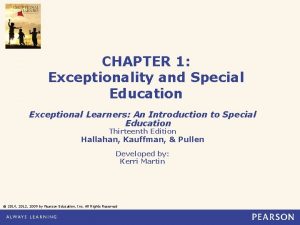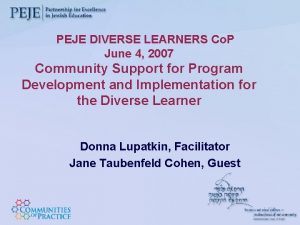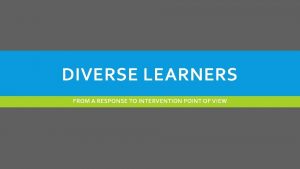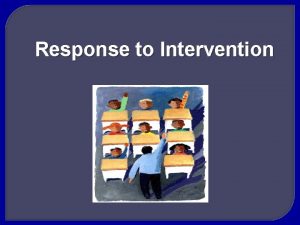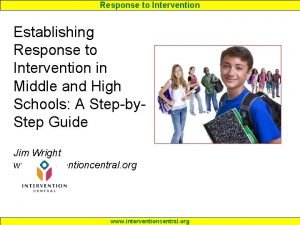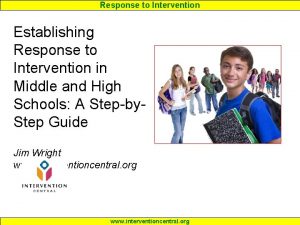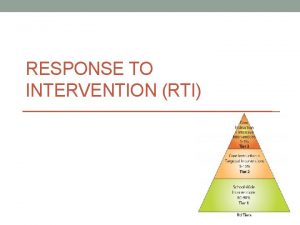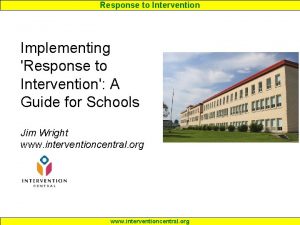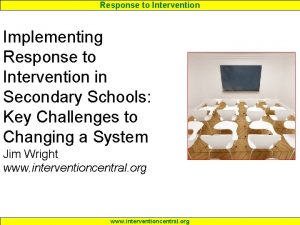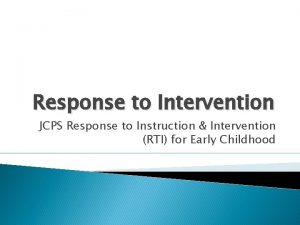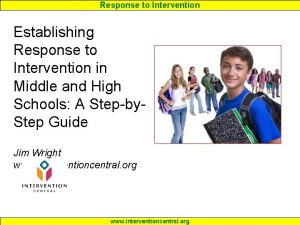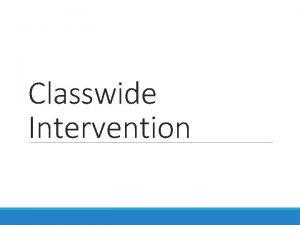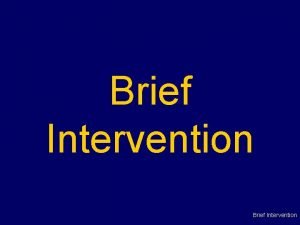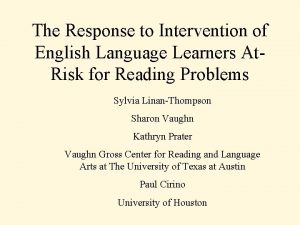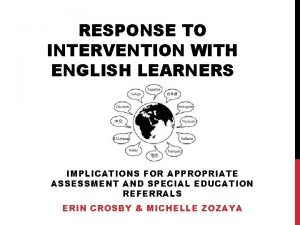PEJE Diverse Learners Co P Response to Intervention






























- Slides: 30

PEJE Diverse Learners Co. P: Response to Intervention Facilitator: Donna Lupatkin Guest: Dr. Shana Erenberg Hebrew Theological College Date: September 22, 2008

Agenda • Welcome and Introductions • Setting the Context • Introduction to Response to Intervention • Translating Ideas into Practice • Next Steps • On-line Discussions • Future Calls

Introducing our Guest Dr. Shana Erenberg is a professor and the chair of the Department of Education at the Blitstein Institute of Hebrew Theological College in Chicago. Dr. Erenberg also maintains a private practice for the diagnostic evaluation and remediation of learning disabilities and related disorders in children and adults. She is the special needs consultant to the Board of Jewish Education and Community Foundation for Jewish Education of Chicago, and the national special needs consultant for the Union for Reform Judaism. She is also the co-chair of the International Consortium of Jewish Special Educators. Dr. Erenberg has published numerous articles and is a noted lecturer and presenter at national and international education conferences. She is also the founder of the Keshet Sunday School and has served as its director for 20 years.

Setting the Context

Preliminary Discussion Questions • What do you see might be the benefits of RTI to your particular school? • Upon initial consideration, what do you see as the possible costs of not implementing RTI?

Your Ideas What are the potential benefits of RTI? • All staff would have been trained in Differentiated Instruction. Note: this would be a prerequisite. • All appropriate children would have been identified at an early age – when it is critical. There would also be a game-plan in place to meet each child’s needs. • Interventions that are happening in classrooms would help meet the diverse needs of a wide range of students and perhaps avoid a later need for more intensive and costly interventions.

What is the cost of not implementing RTI? • Kids might fall through the cracks. • Families would have to look for other options to meet the needs of their children, possibly in other schools (taking away those children from their siblings and their community). • Some students may need to go to secular programs. • Some communities have no other options of Jewish day schools. • Some students may need to go to other more expensive Jewish day schools or private secular schools. • Some secular programs for students with disabilities put pressure on the student and their parents to stay in their school – thus preventing Jewish students from returning to Jewish day schools. ( Some of these schools have their own agenda and may encourage parents to keep their students where they are, predicting that if they leave they might fail).

Discussion • We need to look at many factors as to why a child may not succeed beyond just the notion of the difficulties inherent in a dual curriculum program. • We would be proactive by using RTI programming, thus preventing possible school wide difficulties. • We want our schools to be thought of as places that are inclusive and where a wide variety of needs that our children present can be attended to.

Introduction to Response to Intervention

Definition of RTI • Tiered system for delivering instruction and remediation to address student learning and behavior needs. • Requires the use of evidence-based interventions and methodology. • Includes initial and ongoing assessment and monitoring of student response and learning. • Services and interventions are adjusted based on student responsiveness.

Tiers and Levels of Intervention • Tier 1 - Primary Level • Differentiated Instruction in a typical classroom. Includes modifications and accommodations. • Tier 2 – Secondary Level • Evidence‑based practices or small‑group tutoring on academic subjects, typically conducted by trained and supervised tutors. • Tier 3 – Tertiary Level • Individualized instruction on modified instructional content and materials, related to the general education program. Smaller groups focus on individual needs or skill deficits, with longer and more frequent sessions.

RTI Tier 3: Individualized Strategies 10 -25 % Tier 2: Effective, Strategic Interventions and Strategies, Progress Monitoring s& on nti rve ring nte ito y-I Mon sit en ss Int ogre Pr 5 -10 % Tier I: Research Based Core Programs, 75 -85 % Universal Screening, Identification of Students with Greater Needs

Identification of Students • Screening measures • Curriculum-based Assessment • Achievement test data • Teacher/specialist observation • Checklists • Problem solving team

Delivery of Services • General Classroom • Smaller teacher/student ratio • Teacher Assistants • Resource Room • Pull-out services • Push-in services • Individualized instruction and small group • Separate classroom

Assess your Setting • What is the greatest need and difficulty in your school? • Would teachers, administrators, or parents have differing responses to the introduction of RTI? • What indicators do you have to suggest that these areas might or might not be problematic?

What is the greatest need/challenge in your school? • Having enough staff trained for the programming. • There needs to be a philosophy of inclusion. • If schools adapt practices, at what point do you have a research-based program? • Having enough time to work with the children that need supplemental work. • Having an ongoing testing program to make sure the students are identified, and those that are identified are making progress. • Making assessment more systematic as opposed just to anecdotal.

Different perspectives regarding RTI • Parents need education about RTI as well as teachers. – Parents may feel that their child is being labeled. – Some parents are supportive of RTI because they see it as being inclusive. – Some parents fear that RTI perpetuates a cycle of failure. • Some teachers may perceive RTI as requiring more work for them because there is more individualization. • The administrators of the school need to convey that inclusive practices are the philosophy of the school.

Translating Ideas into Practice

What RTI Should Be • Proactive in identifying and serving students with needs. • Include an individualized plan for each student, with observable and measureable goals. • Include a variety of research-based interventions. • Provide close monitoring of student progress, with specific, designated time limits. • Include collaboration with specialists. • Encourage parent input and facilitate communication.

What RTI Should Not Be • Preclude or be a substitute for a comprehensive case study evaluation if needed. • Be implemented indefinitely. • Implement a “one size (program) fits all” approach to intervention. • Be used as a cost-cutting measure. • Be staffed by teachers and assistants who are not adequately prepared.

Factors that Contribute to Success of RTI • Faculty that is knowledgeable and willing to differentiate instruction. • Professional development opportunities. • Support and guidance of the administration. • Philosophy of inclusion. • Availability of materials and resources. • Assessment system

Benefits of RTI • Early intervention • Availability of interventions to atrisk students who might not otherwise qualify. • Additional options for the identification of learning disabilities. • Inclusion

Obstacles to Implementation of RTI in the Jewish Day Schools • Trained professionals who are knowledgeable in differentiated instruction and assessment. • Availability of special education teachers for intensive instruction. • Curriculum and materials for General and Judaic Studies. • Time • Financial resources • Attitude and support

Reflection: Using the Model • How could I bring this model into my school? • What changes would it involve? • What kind of staff training would it require? • How would I introduce it to school personnel? • What expenses would it incur?

Next Steps • Assess what you have in place, how things are going, and what you want to be doing. • If you are going forward, assess your professionals on staff. Decide whether they have the skills needed to implement the RTI model. • Consider the role of professional development to assure for success.

School Examples • Some local school districts have become a resource for learning about RTI and can be accessed as a support in training day school professionals. • It remains important to work from the inside out with the administration in preparation for launching RTI. • Start a professional learning community to explore RTI.

The Crown of Our Community • Each individual student is like a beautiful, glittering jewel in the crown of the Jewish community. • If even one jewel is lost, the entire crown is diminished in value. • It is our obligation as Jewish educators to meet the needs of all students, to the best of our abilities.

Discuss Online Diverse Learners Co. P discussion: PEJE_Diverse_Learners@googlegroups. com • To start a new thread of discussion, send an email to the group’s email address. Be sure to create a topic specific • subject and include the text. You can also send attachments with the message. • To reply to the discussion, simply reply to the email as you normally would. For more information or assistance please contact Kirk Tallman at kirk@peje. org.

Future Calls • Monday Nov 3 - Components of an Effective Reading Program for Struggling Readers • Monday Dec 1 or 8 -Including Families and Students with Diverse Needs in the Israel Experience • Monday January 12 -Cutting Edge models and Issues in special Education • TBA-Bullying

PEJE wishes to thank Hidden Sparks for their generous support of this Co. P.
 Technology for diverse learners
Technology for diverse learners How does it move
How does it move National center on response to intervention
National center on response to intervention Simplifying response to intervention
Simplifying response to intervention Response to intervention pyramid
Response to intervention pyramid National center for response to intervention
National center for response to intervention Primary immune response and secondary immune response
Primary immune response and secondary immune response Natural and forced response
Natural and forced response Natural response circuit
Natural response circuit Code of ethics for professional teachers section 5
Code of ethics for professional teachers section 5 Changing results for young learners
Changing results for young learners Nichole atkins
Nichole atkins Teaching young learners english
Teaching young learners english Active learning principles
Active learning principles Kinesthetic learners definition
Kinesthetic learners definition Knec mlp
Knec mlp Ib learners profile
Ib learners profile The learners will be able to
The learners will be able to Quadrant d learners
Quadrant d learners Inheritance characteristics
Inheritance characteristics Active and passive learners
Active and passive learners Objectives of remedial teaching
Objectives of remedial teaching Reading strategies for english language learners
Reading strategies for english language learners Characteristics of attention
Characteristics of attention When is cognitivism beneficial for learners
When is cognitivism beneficial for learners Equal protection for english language learners
Equal protection for english language learners Global vs analytical learners
Global vs analytical learners English language learners
English language learners Gifted education curriculum in the philippines
Gifted education curriculum in the philippines Exceptional learners: an introduction to special education
Exceptional learners: an introduction to special education Fairlie early learners
Fairlie early learners


